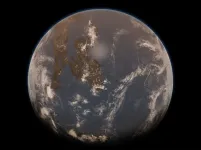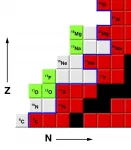(Press-News.org) On sultry summer afternoons, heating, ventilation and air conditioning (HVAC) systems provide much-needed relief from the harsh heat and humidity. These systems, which often come with dehumidifiers, are currently not energy efficient, guzzling around 76% of the electricity in commercial and residential buildings.
In a new study, Texas A&M University researchers have described an organic material, called polyimides, that uses less energy to dry air. Furthermore, the researchers said polyimide-based dehumidifiers can bring down the price of HVAC systems, which currently cost thousands of dollars.
"In this study, we took an existing and rather robust polymer and then improved its dehumidification efficiency," said Hae-Kwon Jeong, McFerrin Professor in the Artie McFerrin Department of Chemical Engineering. "These polymer-based membranes, we think, will help develop the next generation of HVAC and dehumidifier technologies that are not just more efficient than current systems but also have a smaller carbon footprint."
The results of the study are described in the Journal of Membrane Science.
Dehumidifiers remove moisture from the air to a comfortable level of dryness, thereby improving air quality and eliminating dust mites, among other useful functions. The most commonly available dehumidifiers use refrigerants. These chemicals dehumidify by cooling the air and reducing its ability to carry water. However, despite their popularity, refrigerants are a source of greenhouse gases, a major culprit for global warming.
As an alternative material for dehumidification, naturally occurring materials known as zeolites have been widely considered for their drying action. Unlike refrigerants, zeolites are desiccants that can absorb moisture within their water-attractive or hydrophilic pores. Although these inorganic materials are green and have excellent dehumidification properties, zeolite-based dehumidifiers pose challenges of their own.
"Scaling up is a big problem with zeolite membranes," Jeong said. "First, zeolites are expensive to synthesize. Another issue comes from the mechanical properties of zeolites. They are weak and need really good supporting structures, which are quite expensive, driving up the overall cost."
Jeong and his team turned to a cost-effective organic material called polyimides that are well-known for their high rigidity and tolerance for heat and chemicals. At the molecular level, the basic unit of these high-performance polymers are repeating, ring-shaped imide groups connected together in long chains. Jeong said the attractive forces between the imides gives the polymer its characteristic strength and thus an advantage over mechanically weak zeolites. But the dehumidification properties of the polyimide material needed enhancement.
The researchers first created a film by carefully applying polyimide molecules on a few nanometers-wide alumina platforms. Next, they put this film in a highly concentrated sodium hydroxide solution, triggering a chemical process called hydrolysis. The reaction caused the imide molecular groups to break and become hydrophilic. When viewed under a high-powered microscope, the researchers uncovered that the hydrolysis reactions lead to the formation of water-attractive percolation channels or highways within the polyimide material.
When Jeong's team tested their enhanced material for dehumidification, they found that their polyimide membrane was very permeable to water molecules. In other words, the membrane was capable of extracting excess moisture from the air by trapping them in the percolation channels. The researchers noted that these membranes could be operated continuously without the need for regeneration since the trapped water molecules leave from the other side by a vacuum pump that is installed within a standard dehumidifier.
Jeong said his team carefully designed their experiments to partial hydrolysis wherein a controlled number of imide groups become hydrophilic.
"The strength of polyimides comes from their intermolecular forces between their chains," Jeong said. "If too many imides are hydrolyzed, then we are left with weak material. On the other hand, if the hydrolysis is too low, the material won't be effective at dehumidification."
Although polyimide membranes have shown great promise in their potential use in dehumidification, Jeong said their performance still lags behind zeolite membranes.
"This is a new approach to improve the property of a polymer for dehumidification and a lot more optimizations need to be done in order to further enhance the performance of this membrane," Jeong said. "But another key factor for engineering applications is it has to be cheap, especially if you want the technology to be reasonably affordable for homeowners. We are not there yet but are certainly taking strides in that direction."
INFORMATION:
Sunghwan Park in the chemical engineering department also contributed to this study.
This research is funded by the National Science Foundation and the Qatar National Research Fund.
Since early in the COVID-19 pandemic, parents, teachers, and school administrators have faced difficult questions regarding when and how to safely reopen for in-person learning. During the 2020-2021 fall semester, school districts around the United States navigated their reopening plans -- many opting for exclusively online learning or hybrid models -- with little data on how SARS-CoV-2 spreads among children or how in-person learning would impact transmission in the schools' communities. A new study in The Journal of School Health joins a growing body of evidence that, with appropriate measures, there are ways for schools to safely reopen.
In this study, scientists analyzed data from two large, independent k-12 schools that re-opened for in-person learning ...
WASHINGTON--A vast global ocean may have covered early Earth during the early Archean eon, 4 to 3.2 billion years ago, a side effect of having a hotter mantle than today, according to new research.
The new findings challenge earlier assumptions that the size of the Earth's global ocean has remained constant over time and offer clues to how its size may have changed throughout geologic time, according to the study's authors.
Most of Earth's surface water exists in the oceans. But there is a second reservoir of water deep in Earth's interior, in the form of hydrogen and oxygen attached to minerals in the mantle.
A new study in AGU Advances, which publishes high-impact, open-access research and commentary across the Earth and space sciences, estimates how much water ...
A researcher from Skoltech and his German colleagues have developed a neural network-based classification algorithm that can use data from an apple orchard to predict how well apples will fare in long-term storage. The paper was published in Computers and Electronics in Agriculture.
Before the fruit and vegetables we all like end up on our tables, they have to be stored for quite some time, and during this time they can develop physiological disorders such as flesh browning or superficial scald (brown or black patches on the skin of the fruit). These disorders contribute to the loss of a substantial amount ...
Some 8,300 million metric tons of plastics have been manufactured since production exploded in the 1950s, with more than 75 percent ending up as waste and 15 million metric tons reaching oceans every year. Plastic waste fragments into increasingly smaller but environmentally persistent "microplastics," with potentially harmful effects on the health of people, wildlife and ecosystems. A new collection, "Confronting Plastic Pollution to Protect Environmental and Public Health," is publishing on March 30th, 2021 in the open access journal PLOS Biology that addresses critical scientific challenges in understanding the impacts of microplastics.
The collection features three evidence-based commentaries from ecotoxicology and environmental health ...
RESTON, Va. - Greater sage-grouse populations have declined significantly over the last six decades, with an 80% rangewide decline since 1965 and a nearly 40% decline since 2002, according to a new report by the U.S. Geological Survey. Although the overall trend clearly shows continued population declines over the entire range of the species, rates of change do vary regionally.
The report represents the most comprehensive analysis of greater sage-grouse population trends ever produced and lays out a monitoring framework to assess those trends moving forward. The study can also be used to evaluate the effectiveness of greater sage-grouse conservation efforts and analyze factors that contribute to habitat loss and population change -- all critical ...
(Philadelphia, PA) - The human heart works under high demand, constantly pumping oxygen-rich blood through the body. When faced with disease, however, fulfilling this demand can become increasingly difficult and harmful. In the case of chronic high blood pressure - a leading cardiovascular disease in the United States - the heart continuously overexerts, resulting in maladaptive growth and, ultimately, severe dysfunction of the heart muscle itself.
Maladaptive growth of the heart, known as cardiac hypertrophy, is brought about in part by activation of G protein-coupled kinase ...
Researchers at Washington University in St. Louis reported the first observations of a new form of fluorine, the isotope 13F, described in the journal Physical Review Letters.
They made their discovery as part of an experiment conducted at the National Superconducting Cyclotron Laboratory at Michigan State University (MSU).
Fluorine is the most chemically reactive element on the periodic table. Only one isotope of fluorine occurs naturally, the stable isotope 19F. The new isotope, 13F, is four neutrons removed from the proton drip line, the boundary that delimits the zone beyond which atomic nuclei decay by the emission ...
CAMBRIDGE, MA -- More than just a sign of illness, mucus is a critical part of our body's defenses against disease. Every day, our bodies produce more than a liter of the slippery substance, covering a surface area of more than 400 square meters to trap and disarm microbial invaders.
Mucus is made from mucins -- proteins that are decorated with sugar molecules. Many scientists are trying to create synthetic versions of mucins in hopes of replicating their beneficial traits. In a new study, researchers from MIT have now generated synthetic mucins with a polymer backbone that more accurately mimic the structure and function of naturally occurring mucins. The team also showed that these synthetic mucins could effectively neutralize the bacterial toxin that causes cholera.
The ...
A study conducted at the University of Campinas (UNICAMP) in the state of São Paulo, Brazil, shows that compounds produced by gut microbiota (bacteria and other microorganisms) during fermentation of insoluble fiber from dietary plant matter do not affect the ability of the novel coronavirus SARS-CoV-2 to enter and replicate in cells lining the intestines. However, while in vitro treatment of cells with these molecules did not significantly influence local tissue infection, it reduced the expression of a gene that plays a key role in viral cell entry and a cytokine receptor that favors inflammation.
An ...
HERSHEY, Pa. -- Stress, increased free time and feelings of boredom may have contributed to an increase in the number of cigarettes smoked per day during the early months of the COVID-19 pandemic by nearly a third of surveyed Pennsylvania smokers. Penn State College of Medicine researchers said understanding risk factors and developing new strategies for smoking cessation and harm reduction may help public health officials address concerning trends in tobacco use that may have developed as a result of the pandemic.
Jessica Yingst, assistant professor of public health sciences and Penn State Cancer Institute researcher, said smokers who increased the number of cigarettes they smoked per day could be at greater risk of dependence and have a more difficult ...




